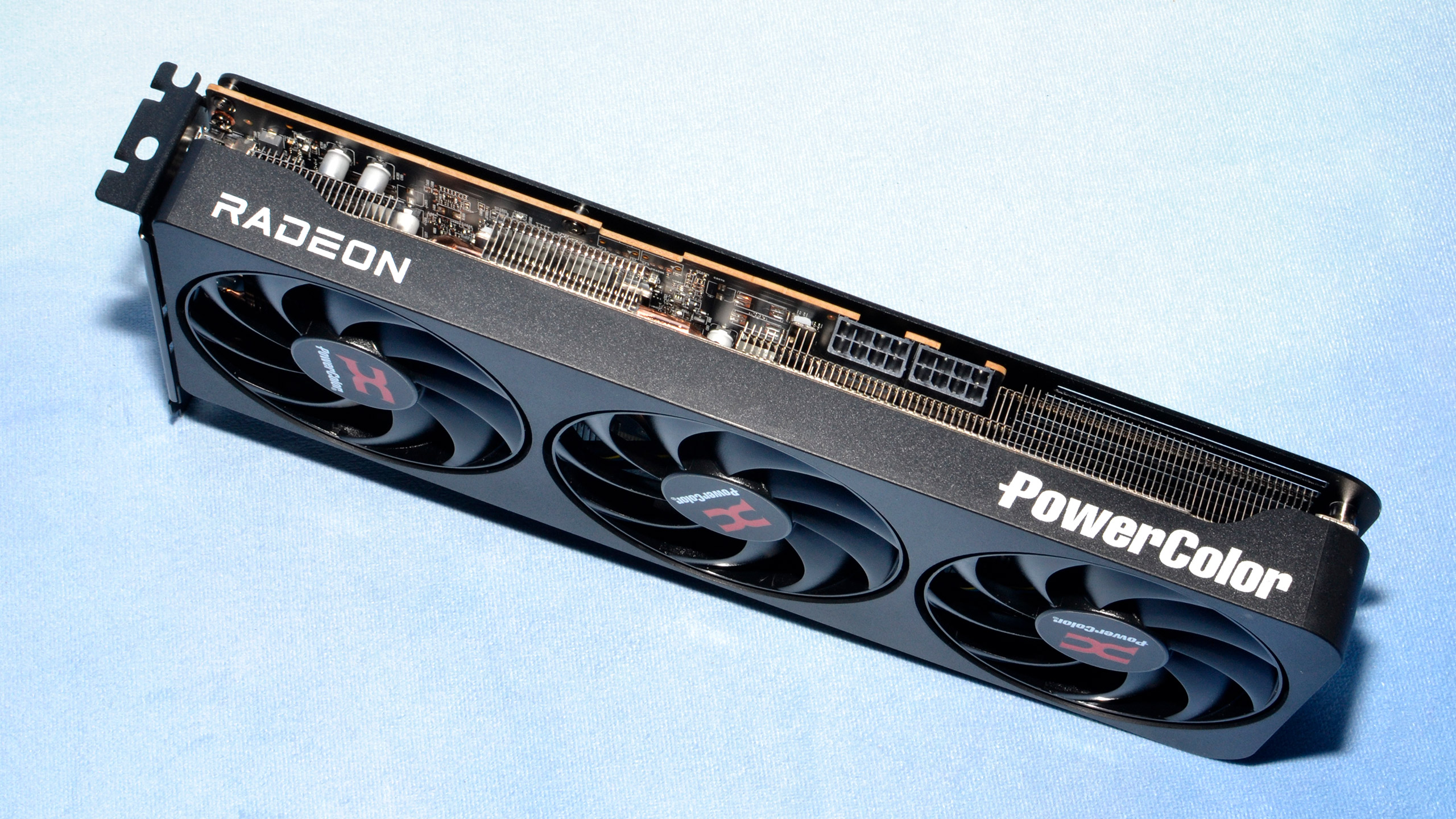Undervolted RX 9070 XT beats RTX 5080 — RX 9070 and 9070 XT models with heavy coolers have massive OC headroom
Multiple online tests affirm the power of AMD's undervolting curve

AMD's newest RX 9070 XT and RX 9070 graphics cards are setting the gaming world on fire, or they would be if not for limited supply and MSRP markups. For the lucky few who managed to get their hands on the cards, the 9070 XT can seemingly edge past Nvidia's RTX 5080 in real-world performance, thanks only to undervolting the card.
YouTube overclockers Der8auer and Alva Jonathan have shown off the most impressive boosts on the RX 9070 and 9070 XT this week. By only adjusting the power target and undervoltage curves of the GPUs in software, both YouTubers saw 10% boosts to FPS in Cyberpunk 2077 on both cards. Of note is that both of these boosts came without adjusting the GPU clock speed offset in software. The GPUs' clock speeds did increase thanks to the undervolt, but the offset remained unedited.
| Row 0 - Cell 0 | Avg FPS | GPU Clock Speed (GHz) | GPU Max Power Draw (W) | GPU Voltage Offset (mV) | GPU Power Target |
RX 9070 XT (OC) | 66 | 3.36 | 358 | -170 | 110% |
RX 9070 XT (Stock) | 60 | 2.90 | 339 | 0 | 100% |
Nvidia FE RTX 5080 (Stock) | 65 | 2.61 | 336 | 0 | 100% |
RX 9070 (OC) | 60 | 3.00 | 270 | -125 | 110% |
RX 9070 (Stock) | 54 | 2.60 | 244 | 0 | 100% |
Both YouTubers tested with testbenches different enough that we should add a disclaimer that the above table does not portray a fair comparison between the RX 9070 XT and 9070 (slightly different CPUs and RAM were used between both Der8auer and Jonathan's testing arrays), but the RTX 5080 and RX 9070 XT as tested by Der8auer were on equal testing ground.
Der8auer tested with the PowerColor RX 9070 XT Red Devil, which sits near the pinnacle of RX 9070 XT factory-overclocked models. Interestingly, testing with increased clock speed offsets did not make any difference in his measured clock speeds or performance, likely because the card is already overclocked to its board limit from the factory. Overclocking the GPU's VRAM also resulted in higher clock speeds, but lower in-game performance; this is due to built-in error correction on the VRAM recalculating failed errors rather than displaying bad voxels.
Der8auer found the best results through increasing the GPU's power target to 110%, and then applying a GPU voltage offset of -170mV, allowing the RX 9070 XT to hit 3.36 GHz and see a 10% boost in FPS over a similar XTX-brand RX 9070 XT.
With AMD's Radeon software, undervolting a GPU does not simply lower the voltage it runs at. Instead, changing the voltage offset moves the voltage-frequency curve higher or lower, thus lowering the voltage required to hit higher frequencies. A fair comparison would be tuning a car's automatic transmission so a lower RPM is needed before automatically shifting to the next gear.
Alva Jonathan's testing used the ASRock RX 9070 Steel Legend, another heavily factory-overclocked model. Like Der8auer, adjusting GPU clock offsets did not result in much change for Jonathan, who also employed a similar voltage and power draw adjustment to hit a matching 10% boost in FPS. He also employed similar means to undervolt and under-power the board to hit the lowest power draw possible, a solid method for preserving the lifetime of the GPU.
Get Tom's Hardware's best news and in-depth reviews, straight to your inbox.
Remember that both YouTubers tested with cards heavily overclocked from the factory, and (normally) selling for well above MSRP. The PowerColor Red Devil initially sold for $799 on Newegg, $200 above MSRP for the RX 9070 XT at launch. Likewise, the ASRock Steel Legend board was listed at $640, a cool $90 above MSRP for the RX 9070. With these markups comes better PCBs and much-improved cooling, which may be the silver bullet allowing for such aggressive undervolts to remain stable.
Still, in the magical Christmas land where new GPUs sell for MSRP, the PowerColor Red Devil still sits $200 cheaper than the RTX 5080, and can now surpass it in Cyberpunk 2077 (and a few other benchmarks which can be seen in Der8auer's testing) after some creative overclocking and tweaking. While ray-tracing, path-tracing, and software support are all Nvidia's games to lose, AMD puts up stiff competition with this undervolting-capable card — and does it without needing to be bundled with a smoke alarm.

Sunny Grimm is a contributing writer for Tom's Hardware. He has been building and breaking computers since 2017, serving as the resident youngster at Tom's. From APUs to RGB, Sunny has a handle on all the latest tech news.
-
Gururu I saw Derbauer's video on this and I don't understand although this article helped a lot. So one has to lower the voltage, increase the power draw and increase the frequency? Which setting is the most risky to the life of the card?Reply -
baranlai Reply
Nope, only lower the voltage and increase power limit. The card itself reaches higher clock speeds due to higher power limit with less heat due to lower voltage.Gururu said:I saw Derbauer's video on this and I don't understand although this article helped a lot. So one has to lower the voltage, increase the power draw and increase the frequency? Which setting is the most risky to the life of the card? -
A Stoner AMD did not leave that sitting on the floor for no reason. Some chips might have massive headroom for additional performance, and likely many, more than 30% have little room for additional performance. Particularly for the 9070 since they likely bin chips and put the worst but acceptable ones in the 9070.Reply -
SonoraTechnical I would have liked to have seen benchmarks against the Radeon RX 7900 XTX... just to see how close it can get...Reply -
ohio_buckeye Very interesting. Might leave the door open for a 9070xtx if they start binning the gpus further.Reply -
talkischeapc9 Good luck getting pre-binned reviewer GPU's. Your GPU will likely never come close to the OC's they are getting. Also show numbers with Ray tracing so we can see actual differences. Cyberpunk looks like a different game with RT on.Reply -
thestryker Reply
Currently setting the clocks doesn't work quite right so there weren't any changes there in these tests. What happened to increase the frequency is the extra power headroom from raising the power limit combined with lowering the voltage. There is no risk to the card longevity in doing these things (both AMD and nvidia heavily limit how high the power target can go) the only risk is to stability.Gururu said:I saw Derbauer's video on this and I don't understand although this article helped a lot. So one has to lower the voltage, increase the power draw and increase the frequency? Which setting is the most risky to the life of the card?
I've run my card undervolted for almost the entire time and it has done very well. I mostly did it because I prefer running at 75% power (300W vs 400W for my model) and this allows the card to still maintain close to stock performance at that power limit. When I do raise the power limit back up it means extra performance there too. -
usertests Replyohio_buckeye said:Very interesting. Might leave the door open for a 9070xtx if they start binning the gpus further.
Revive that 32 GB rumor back from the dead!ezst036 said:Sounds like AMD could create an RX9080 card if they make some small changes.

